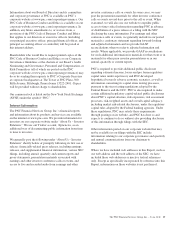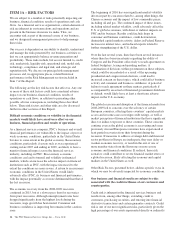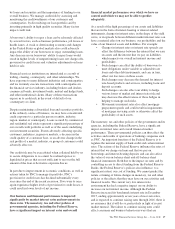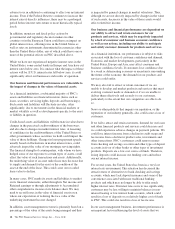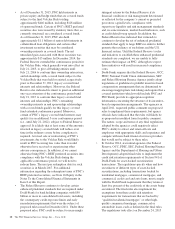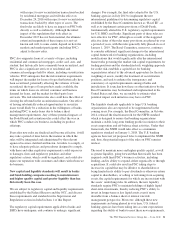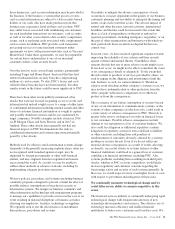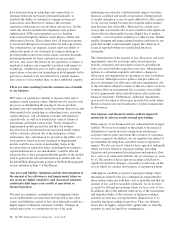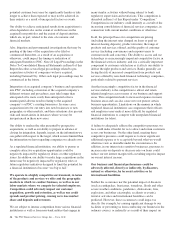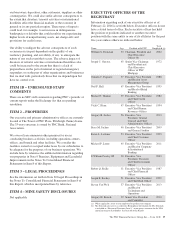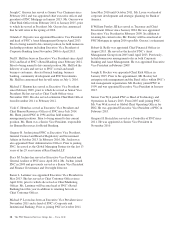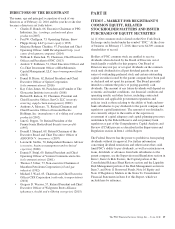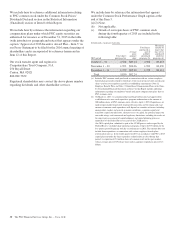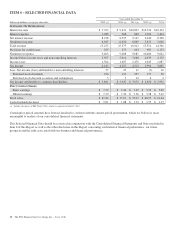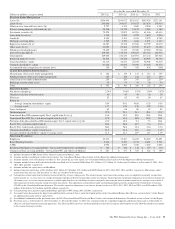PNC Bank 2015 Annual Report Download - page 42
Download and view the complete annual report
Please find page 42 of the 2015 PNC Bank annual report below. You can navigate through the pages in the report by either clicking on the pages listed below, or by using the keyword search tool below to find specific information within the annual report.have been investing in technology and connectivity to
automate functions previously performed manually, to
facilitate the ability of customers to engage in financial
transactions, and otherwise to enhance the customer
experience with respect to our products and services. On the
retail side, this has included developments such as more
sophisticated ATMs and expanded access to banking
transactions through the internet, smart phones, tablets and
other remote devices. These efforts have all been in response
to actual and anticipated customer behavior and expectations.
Our continued success depends, in part, upon our ability to
address the needs of our customers by using technology to
provide products and services that satisfy customer demands,
including demands for faster and more secure payment
services, and create efficiencies in our operations. A failure to
maintain or enhance our competitive position with respect to
technology, whether because we fail to anticipate customer
expectations or because our technological developments fail to
perform as desired or are not rolled out in a timely manner,
may cause us to lose market share or incur additional expense.
There are risks resulting from the extensive use of models
in our business.
PNC relies on quantitative models to measure risks and to
estimate certain financial values. Models may be used in such
processes as determining the pricing of various products,
grading loans and extending credit, measuring interest rate and
other market risks, predicting or estimating losses, assessing
capital adequacy, and calculating economic and regulatory
capital levels, as well as to estimate the value of financial
instruments and balance sheet items. Poorly designed or
implemented models present the risk that our business
decisions based on information incorporating model output
will be adversely affected due to the inadequacy of that
information. Also, information we provide to the public or to
our regulators based on poorly designed or implemented
models could be inaccurate or misleading. Some of the
decisions that our regulators make, including those related to
capital distributions to our shareholders, could be affected
adversely due to their perception that the quality of the models
used to generate the relevant information is insufficient. See
the Model Risk Management portion of the Risk Management
section included in Item 7 of this Report.
Our asset and liability valuations and the determination of
the amount of loss allowances and impairments taken on
our assets are highly subjective, and inaccurate estimates
could materially impact our results of operations or
financial position.
We must use estimates, assumptions, and judgments when
assets and liabilities are measured and reported at fair value.
Assets and liabilities carried at fair value inherently result in a
higher degree of financial statement volatility. Changes in
underlying factors or assumptions in any of the areas
underlying our estimates could materially impact our future
financial condition and results of operations. During periods
of market disruption, it may be more difficult to value certain
of our assets if trading becomes less frequent and/or market
data becomes less observable. There may be certain asset
classes that were historically in active markets with significant
observable data that rapidly become illiquid due to market
volatility, a loss in market confidence or other factors. Further,
rapidly changing and unprecedented market conditions in any
particular market could materially impact the valuation of
assets as reported within our consolidated financial
statements.
The determination of the amount of loss allowances and asset
impairments varies by asset type and is based upon our
periodic evaluation and assessment of known and inherent
risks associated with the respective asset class. Management
updates its evaluations regularly and reflects changes in
allowances and impairments in operations as such evaluations
are revised. Although we have policies and procedures in
place to determine loss allowance and asset impairments, due
to the substantial subjective nature of this area, there can be no
assurance that our management has accurately assessed the
level of impairments taken and allowances reflected in our
financial statements. Furthermore, additional impairments
may need to be taken or allowances provided for in the future.
Historical trends may not be indicative of future impairments
or allowances.
Our business and financial results could be impacted
materially by adverse results in legal proceedings.
Many aspects of our business involve substantial risk of legal
liability. We have been named or threatened to be named as
defendants in various lawsuits arising from our business
activities (and in some cases from the activities of companies
we have acquired). In addition, we are regularly the subject of
governmental investigations and other forms of regulatory
inquiry. We also are at risk when we have agreed to indemnify
others for losses related to legal proceedings, including
litigation and governmental investigations and inquiries, they
face, such as in connection with the sale of a business or assets
by us. The results of these legal proceedings could lead to
significant monetary damages or penalties, restrictions on the
way in which we conduct our business, or reputational harm.
Although we establish accruals for legal proceedings when
information related to the loss contingencies represented by
those matters indicates both that a loss is probable and that the
amount of loss can be reasonably estimated, we do not have
accruals for all legal proceedings where we face a risk of loss.
In addition, due to the inherent subjectivity of the assessments
and unpredictability of the outcome of legal proceedings,
amounts accrued may not represent the ultimate loss to us
from the legal proceedings in question. Thus, our ultimate
losses may be higher, and possibly significantly so, than the
amounts accrued for legal loss contingencies.
24 The PNC Financial Services Group, Inc. – Form 10-K



